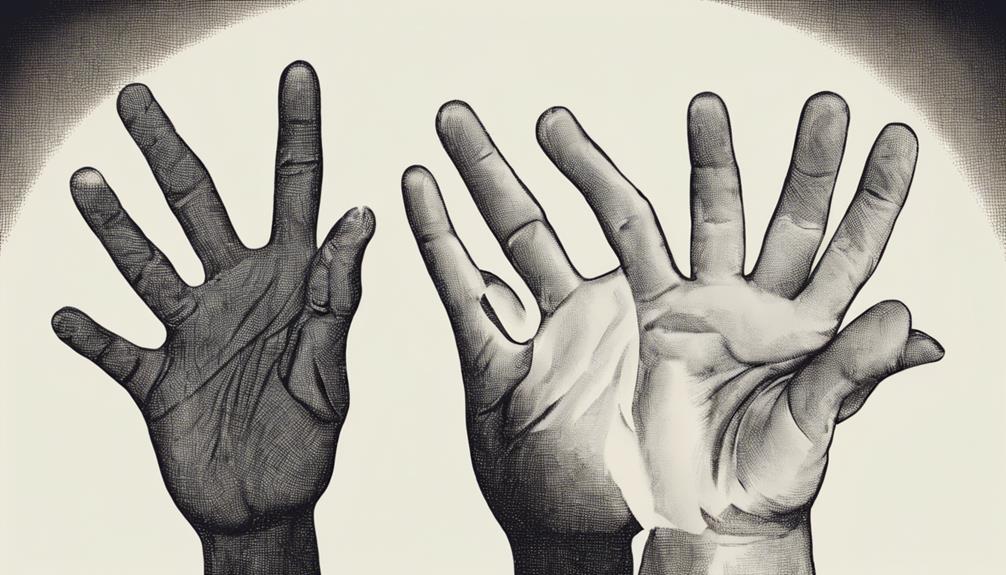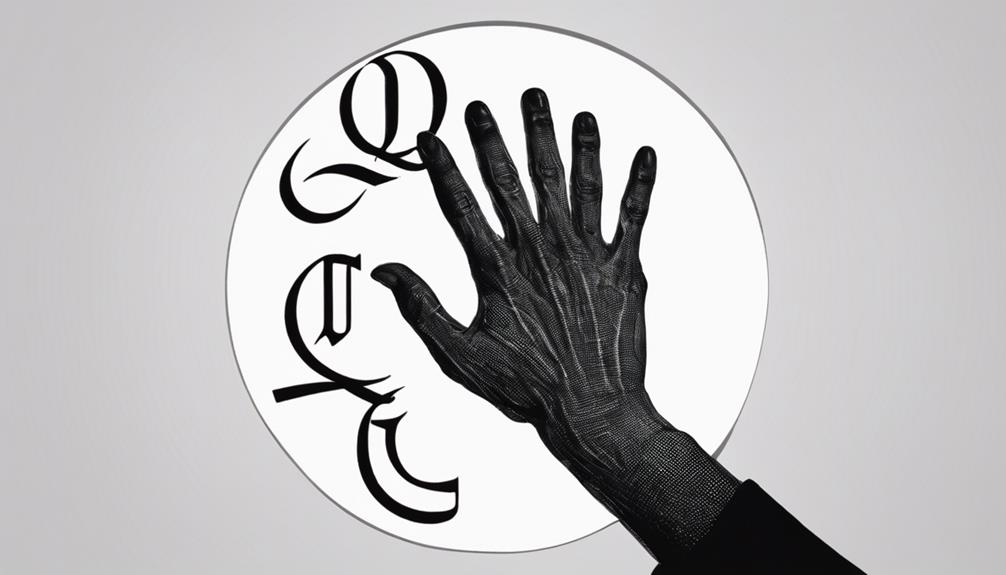As we begin the process of learning the Q sign in American Sign Language (ASL), envision it as deciphering a challenging puzzle that awaits resolution. The detailed aspects of this specific sign are crucial for gaining a more profound insight into ASL communication.
Let's explore the nuances of forming the Q sign and delve into its significance within the deaf community. Understanding the subtleties of this sign not only enhances our signing skills but also opens doors to meaningful interactions that transcend language barriers.
Key Takeaways
- Proper formation crucial for clear communication.
- Practice enhances proficiency in fingerspelling.
- Distinguish Q sign from similar handshapes.
- Regular practice ensures fluency and accuracy.
Importance of the Q Sign
Understanding the importance of the Q sign in American Sign Language is crucial for effective communication and inclusivity in interactions with individuals who are deaf or hard of hearing. The Q sign plays a significant role in fingerspelling words, names, and concepts that start with the letter Q in ASL. By mastering the Q sign, we can ensure clear and accurate communication with deaf people who rely on ASL for everyday interactions. This proficiency in the Q sign not only enhances our overall communication skills but also promotes inclusivity by breaking down barriers in diverse settings.
Moreover, incorporating the Q sign in our ASL vocabulary demonstrates respect for deaf culture and fosters meaningful cross-cultural connections. It's through understanding and utilizing the Q sign that we can bridge communication gaps and create a more inclusive environment for all individuals, regardless of their hearing abilities. Embracing the importance of the Q sign is a vital step towards becoming better allies to the deaf community and promoting accessibility in our interactions.
Proper Forming of the Q Sign

To effectively master the Q sign in American Sign Language (ASL), it's crucial to understand the proper formation technique for this essential handshape. The Q sign is created by extending the dominant forefinger and thumb downward with the palm facing down, similar to the manual letter G but held upside down.
When forming the Q sign, remember to tuck the remaining fingers into the palm while pointing the forefinger and thumb downward. This specific palm orientation distinguishes the Q sign from other handshapes.
Incorporating the Q sign into fingerspelling can significantly enhance your signing proficiency in ASL. Mastering the proper formation of the Q sign is vital for clear and effective communication in ASL.
Practice and repetition are key to perfecting the Q sign's formation, ensuring accuracy and fluency in your signing. By focusing on the correct palm orientation and finger positioning, you can confidently Sign the Letter Q in ASL with precision and clarity.
Nuances in Using the Q Sign
Exploring the intricacies of incorporating the Q sign into ASL communication adds depth and precision to our signing proficiency. When signing the letter Q, attention to detail is key, especially in aspects like palm facing, finger curl, and handshape.
Here are some nuances to consider:
- Palm Facing: Ensure the palm is facing downwards when signing the Q, distinguishing it from the G sign.
- Handshape: Maintain a horizontal hand with the index finger and thumb extended to form the Q.
- Finger Curl: Keep the fingers slightly curled, emphasizing the distinctive shape of the letter Q.
- Orientation: Pay close attention to the orientation of the hand to accurately convey the intended letter.
- Practice Regularly: Practicing the Q sign regularly enhances fluency and muscle memory, promoting confident and accurate signing skills.
Mastering these subtleties not only improves communication but also fosters stronger connections within the deaf and hard-of-hearing community.
Common Misconceptions About the Q Sign

Let's debunk some misconceptions surrounding the Q sign in American Sign Language, particularly addressing common confusions with the G sign. One prevalent misconception is mistaking the Q sign for the G sign due to their similar handshapes.
The Q sign involves pointing the index finger and thumb downward with the palm facing down, distinct from other signs. Some language users may find it challenging to differentiate between these two manual alphabets, leading to potential misunderstandings in communication.
Understanding the unique features of the Q sign is crucial for accurate fingerspelling and clear communication with deaf or hard-of-hearing individuals. By learning the correct formation and execution of the Q sign, one can enhance fluency and proficiency in ASL communication.
Clearing up these misconceptions is essential for effective communication and ensuring accurate interpretation of the intended message.
Enhancing Communication With the Q Sign
Enhancing communication with the Q sign in American Sign Language involves mastering the unique handshape and understanding its distinct features for effective fingerspelling and clear interaction within the deaf community. When holding your dominant hand to make the Q sign, it's essential to maintain a firm grip while keeping the palm facing down.
To enhance your communication skills with the Q sign, consider the following:
- Practice the proper handshape by extending the forefinger and thumb downward.
- Remember that the Q sign resembles the letter G but with a playful twist.
- Utilize fingerspelling techniques, such as the bounce method for double letters like in 'SHAQQA.'
- Engage in the process of learning by practicing signing fluency with the letter Q.
- Pay attention to grammar and structure when incorporating the Q sign into your conversations to ensure clear and effective communication.
Frequently Asked Questions
How Do You Sign Q in Asl?
When signing the letter Q in ASL, we extend our dominant forefinger and thumb downward with the palm facing down.
It's similar to the manual letter G but with a playful twist when held upside down.
How Do You Sign Really Good in Asl?
When we sign 'really good' in ASL, we combine the signs for 'very good' or 'excellent' with positive facial expressions. To sign 'very good,' we make a V shape with both hands, palms facing inward, and move them slightly up and down.
It's essential to express enthusiasm and positivity through facial expressions. Practicing in different contexts helps reinforce understanding and fluency. Body language and non-manual signals convey the intensity of 'really good' in ASL.
What Is the Sign for Secret in Asl?
We've got the scoop on the sign for 'secret' in ASL!
This sign involves bringing one hand up to the mouth, circling the index finger, and tapping the side of the mouth twice.
It's all about conveying secrecy and confidentiality.
Remember to maintain that secretive facial expression while signing.
Using the 'secret' sign in ASL can really enhance communication, especially in discussions where privacy is crucial.
What Is Z in Sign Language?
Sure!
Z in American Sign Language involves extending the index and middle fingers while curling the others into the palm, pointing downward with the palm facing the signer. This handshape is used in fingerspelling and for words starting with Z.
Mastering signing Z accurately is crucial for effective communication and language proficiency in ASL. It's a fundamental part of the manual alphabet and enhances overall signing skills.
Conclusion
Mastering the Q sign in American Sign Language not only improves fluency but also fosters connections within the deaf community. By practicing the proper forming and nuances of the sign, we can enhance communication and create a more inclusive society.
Let's continue to learn and grow in our signing proficiency, embracing the beauty and importance of sign language in connecting with others. Together, let's sign our way to meaningful connections and understanding.











